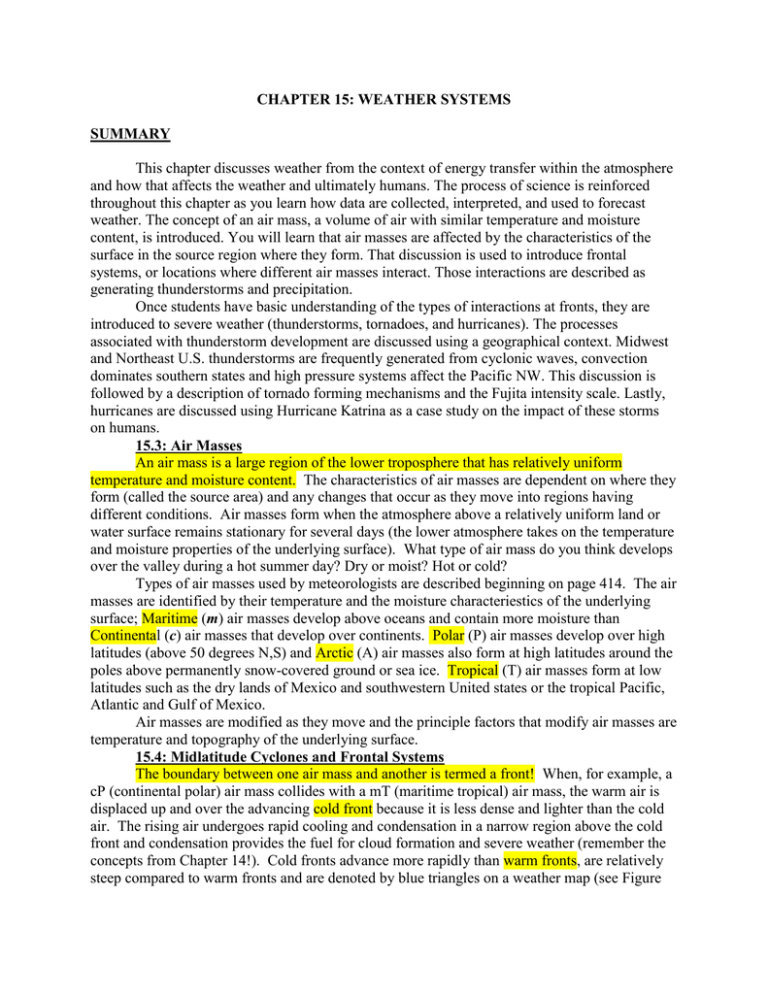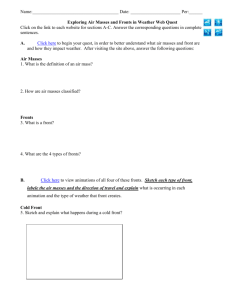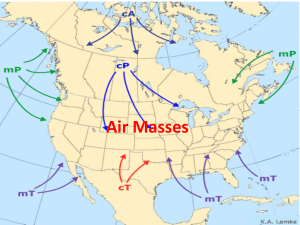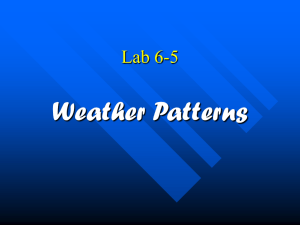CHAPTER 15: WEATHER SYSTEMS SUMMARY
advertisement

CHAPTER 15: WEATHER SYSTEMS SUMMARY This chapter discusses weather from the context of energy transfer within the atmosphere and how that affects the weather and ultimately humans. The process of science is reinforced throughout this chapter as you learn how data are collected, interpreted, and used to forecast weather. The concept of an air mass, a volume of air with similar temperature and moisture content, is introduced. You will learn that air masses are affected by the characteristics of the surface in the source region where they form. That discussion is used to introduce frontal systems, or locations where different air masses interact. Those interactions are described as generating thunderstorms and precipitation. Once students have basic understanding of the types of interactions at fronts, they are introduced to severe weather (thunderstorms, tornadoes, and hurricanes). The processes associated with thunderstorm development are discussed using a geographical context. Midwest and Northeast U.S. thunderstorms are frequently generated from cyclonic waves, convection dominates southern states and high pressure systems affect the Pacific NW. This discussion is followed by a description of tornado forming mechanisms and the Fujita intensity scale. Lastly, hurricanes are discussed using Hurricane Katrina as a case study on the impact of these storms on humans. 15.3: Air Masses An air mass is a large region of the lower troposphere that has relatively uniform temperature and moisture content. The characteristics of air masses are dependent on where they form (called the source area) and any changes that occur as they move into regions having different conditions. Air masses form when the atmosphere above a relatively uniform land or water surface remains stationary for several days (the lower atmosphere takes on the temperature and moisture properties of the underlying surface). What type of air mass do you think develops over the valley during a hot summer day? Dry or moist? Hot or cold? Types of air masses used by meteorologists are described beginning on page 414. The air masses are identified by their temperature and the moisture characteriestics of the underlying surface; Maritime (m) air masses develop above oceans and contain more moisture than Continental (c) air masses that develop over continents. Polar (P) air masses develop over high latitudes (above 50 degrees N,S) and Arctic (A) air masses also form at high latitudes around the poles above permanently snow-covered ground or sea ice. Tropical (T) air masses form at low latitudes such as the dry lands of Mexico and southwestern United states or the tropical Pacific, Atlantic and Gulf of Mexico. Air masses are modified as they move and the principle factors that modify air masses are temperature and topography of the underlying surface. 15.4: Midlatitude Cyclones and Frontal Systems The boundary between one air mass and another is termed a front! When, for example, a cP (continental polar) air mass collides with a mT (maritime tropical) air mass, the warm air is displaced up and over the advancing cold front because it is less dense and lighter than the cold air. The rising air undergoes rapid cooling and condensation in a narrow region above the cold front and condensation provides the fuel for cloud formation and severe weather (remember the concepts from Chapter 14!). Cold fronts advance more rapidly than warm fronts, are relatively steep compared to warm fronts and are denoted by blue triangles on a weather map (see Figure 15.10 and 15.11). Weather changes accompanying warm fronts are usually less severe than the passage of cold fronts because warm air rises above a more gently sloping warm front (which results in precipitation over bigger areas but usually less severe weather). Warm fronts are denoted by red semi-circles on a weather map. When cold fronts catch up to warm fronts they can merge and form occluded fronts (warm air rises between cooler air masses (see Figure 15.13). Midlatitude Cyclones Much of the weather experienced over the eastern United States is a result of the west-toeast migration of regional-scale low pressure systems known as midlatitude cyclones. These tend to dominate weather patterns in the United States when continental polar air masses from the north (Canada, Alaska) collide with marine tropical air masses from the Gulf of Mexico. See Figure 15.12 on page 419 for the three stages in the development of a midlatitude cyclone over the United States. Checkpoint 15.9: The map (above) illustrates the relative positions of a warm front and cold front. Where is the warm front located? a) Between A and B b) Between C and D c) At E Where is it raining? (see map above) a) A and B b) B and C c) C and D d) B and D To answer the second question above it is helpful to look at Table 15.1 on page 417. 15.5 and 15.6: Severe Weather: Thunderstorms and Tornadoes and Hurricanes Read on! Checkpoint 15.14: Updrafts responsible for the formation of thunderstorm clouds are most likely to occur with which combination of conditions? a) Low-level warm, moist air; upper-level warm, moist air b) Low-level cool, dry air; upper-level warm, moist air c) Low-level warm, moist air; upper-level cool, dry air d) Low-level cool, dry air; upper-level cool, dry air LEARNING OBJECTIVES 1. Students will explain concepts related to weather systems. 2. Students will recognize the role of technology in our knowledge of weather patterns and forecasts. 3. Students will classify air masses based on their locations. 4. Students will compare and contrast warm, cold, and occluded fronts. 5. Students will synthesize the development of mid-latitude cyclones and frontal systems. 6. Students will describe the process of thunderstorm, tornado, and hurricane formation. 7. Students will recognize when/where tornadoes are most likely to occur. 8. Students will place hurricanes within the context of the Earth system.









